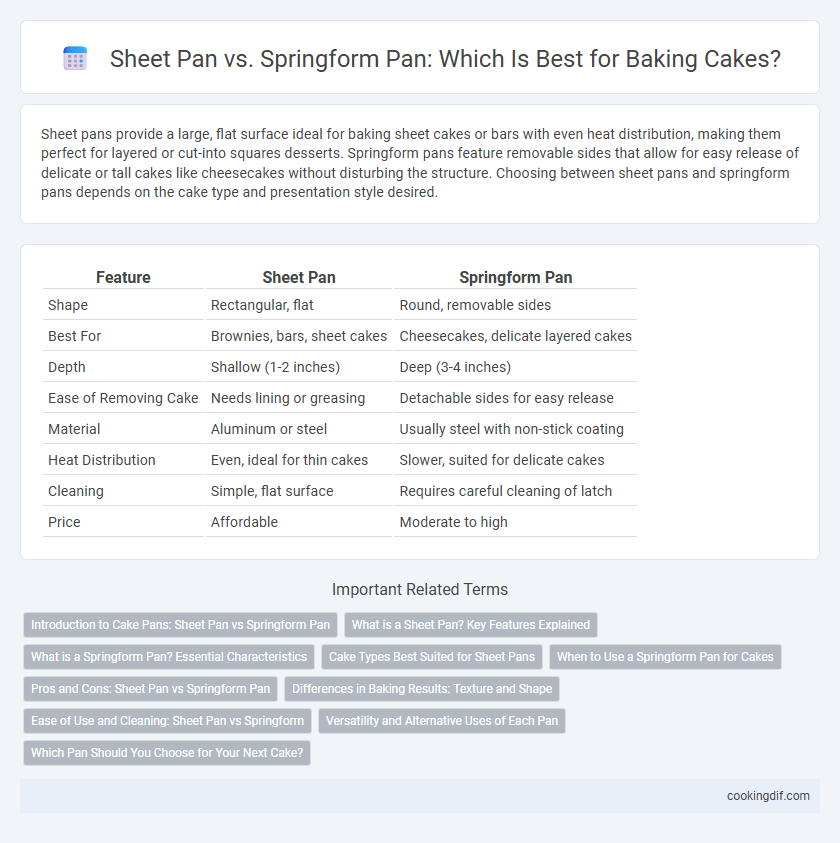Sheet pans provide a large, flat surface ideal for baking sheet cakes or bars with even heat distribution, making them perfect for layered or cut-into squares desserts. Springform pans feature removable sides that allow for easy release of delicate or tall cakes like cheesecakes without disturbing the structure. Choosing between sheet pans and springform pans depends on the cake type and presentation style desired.
Table of Comparison
| Feature | Sheet Pan | Springform Pan |
|---|---|---|
| Shape | Rectangular, flat | Round, removable sides |
| Best For | Brownies, bars, sheet cakes | Cheesecakes, delicate layered cakes |
| Depth | Shallow (1-2 inches) | Deep (3-4 inches) |
| Ease of Removing Cake | Needs lining or greasing | Detachable sides for easy release |
| Material | Aluminum or steel | Usually steel with non-stick coating |
| Heat Distribution | Even, ideal for thin cakes | Slower, suited for delicate cakes |
| Cleaning | Simple, flat surface | Requires careful cleaning of latch |
| Price | Affordable | Moderate to high |
Introduction to Cake Pans: Sheet Pan vs Springform Pan
Sheet pans offer a flat, rectangular baking surface ideal for sheet cakes, brownies, and layered desserts, providing even baking and easy slicing. Springform pans feature removable sides secured by a latch, making them perfect for delicate cheesecakes and tortes that require careful release without inverting. Choosing between sheet pans and springform pans depends on the cake type, desired presentation, and ease of removal.
What is a Sheet Pan? Key Features Explained
A sheet pan, also known as a baking sheet, is a flat, rectangular metal pan with low edges typically made from aluminum or stainless steel, designed for baking cookies, sheet cakes, and roasting vegetables. Its shallow sides, usually about 1 inch high, allow for even heat distribution and easy removal of baked goods. The versatility of sheet pans makes them ideal for thin cakes and bars, but they lack the deep sides necessary for layered or tall cakes commonly baked in springform pans.
What is a Springform Pan? Essential Characteristics
A springform pan features removable sides secured by a latch, allowing easy release of delicate cakes without flipping. Typically made from metal with a non-stick coating, it is ideal for cheesecakes and layered cakes that require gentle handling. Its essential characteristics include a leak-proof bottom and a secure locking mechanism to prevent batter spills during baking.
Cake Types Best Suited for Sheet Pans
Sheet pans are ideal for baking bars, brownies, and sheet cakes due to their large, flat surface that ensures even cooking and easy cutting into portions. Their low sides promote a crispier edge, perfect for layered cakes sliced into squares or rectangles. Unlike springform pans that work better for tall cheesecakes and delicate tarts, sheet pans excel with thin, moist cakes like lemon bars and sponge cakes.
When to Use a Springform Pan for Cakes
Use a springform pan for delicate or layered cakes that require easy removal without damage, such as cheesecakes, tortes, and chiffon cakes. The removable sides allow for minimal handling, preserving the cake's shape and intricate design. Sheet pans, in contrast, are better suited for flat, simple cakes or bars that do not need structural support during unmolding.
Pros and Cons: Sheet Pan vs Springform Pan
Sheet pans offer even heat distribution and large surface area, making them ideal for sheet cakes and bars but resulting in thinner layers that may lack height and texture. Springform pans provide easy release and tall, structured edges, perfect for layered and delicate cheesecakes, yet they can leak batter and often require a water bath to maintain moisture. Choosing between sheet pans and springform pans depends on the desired cake style, texture, and ease of removal.
Differences in Baking Results: Texture and Shape
Sheet pans produce cakes with a thinner, more even texture due to their large, flat surface area, resulting in crispy edges and a uniform bake. Springform pans create cakes with taller, softer centers and a more defined shape, ideal for delicate cheesecakes or layered desserts. The choice between these pans significantly affects the cake's crumb structure and final presentation.
Ease of Use and Cleaning: Sheet Pan vs Springform
Sheet pans offer straightforward ease of use with their flat, one-piece design, making batter pouring and even baking simple while cleaning involves a quick wipe or soak due to their smooth surface. Springform pans feature removable sides that simplify cake release, ideal for delicate or layered cakes, but the latch mechanism and crevices can complicate cleaning. Choosing between these pans depends on whether convenience in batter handling or post-bake cake removal is prioritized, impacting the overall ease of use and cleaning process.
Versatility and Alternative Uses of Each Pan
Sheet pans excel in versatility, allowing bakers to create a variety of flatbreads, sheet cakes, and bar cookies with ease, while also doubling as roasting trays for vegetables. Springform pans specialize in delicate cakes like cheesecakes and tortes, designed for effortless removal without damaging the structure, but can also be repurposed for layered mousse desserts. Choosing between a sheet pan and a springform pan depends on whether the focus is on broad baking capabilities or preparing intricate, shape-sensitive cakes.
Which Pan Should You Choose for Your Next Cake?
Sheet pans provide even heat distribution ideal for baking flat, uniform cakes like sheet cakes or bars, making them perfect for layered or sliced desserts. Springform pans excel at delicate, creamy cakes such as cheesecakes or tortes, allowing easy removal without damaging the cake's shape due to their removable sides. Choosing between a sheet pan and a springform pan depends on the cake's texture and design requirements for optimal baking results.
Sheet pan vs Springform pan for cake pans Infographic

 cookingdif.com
cookingdif.com